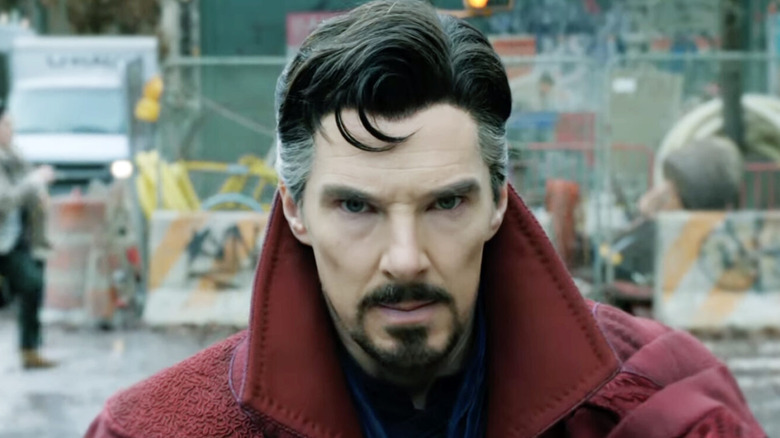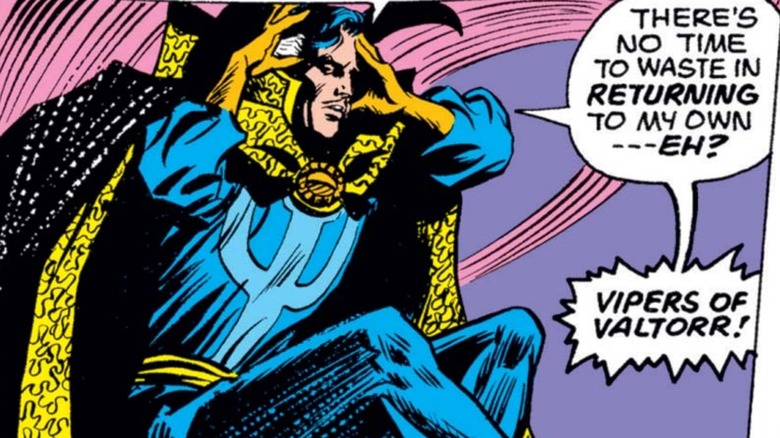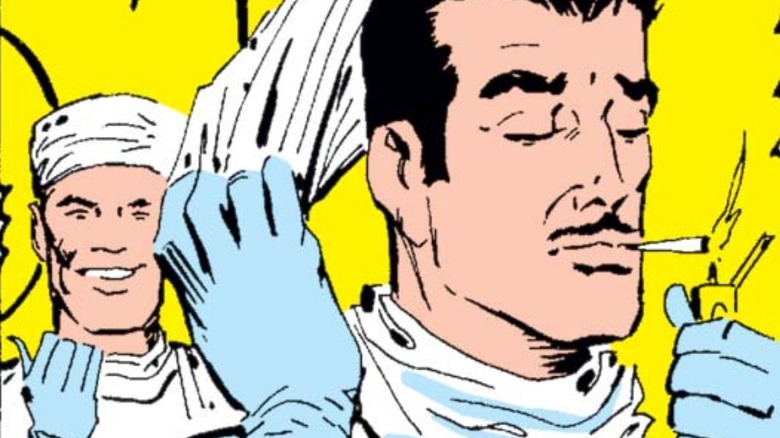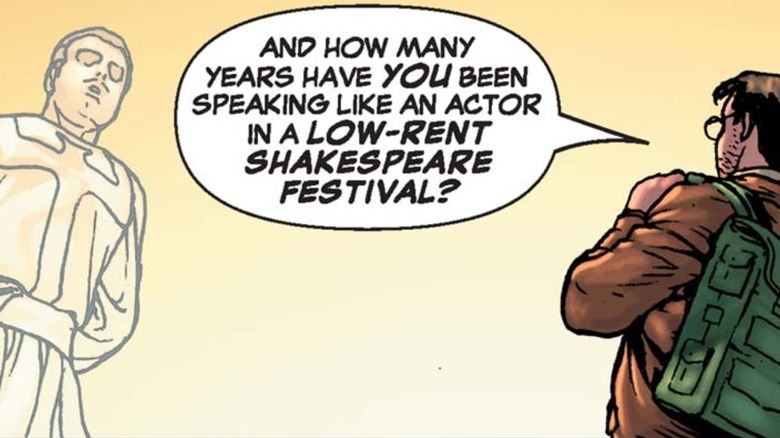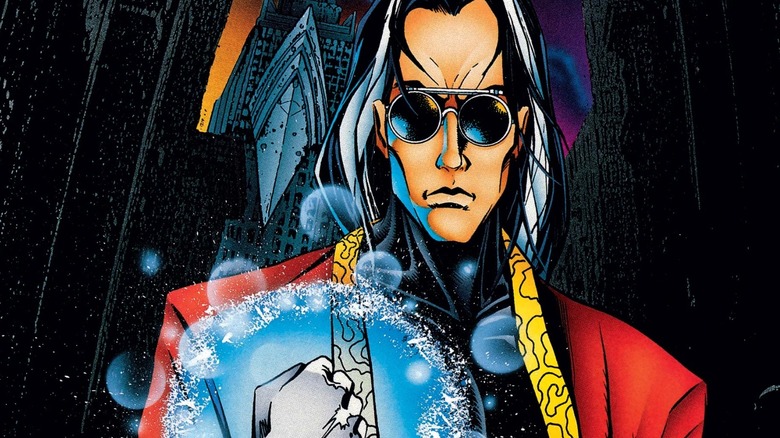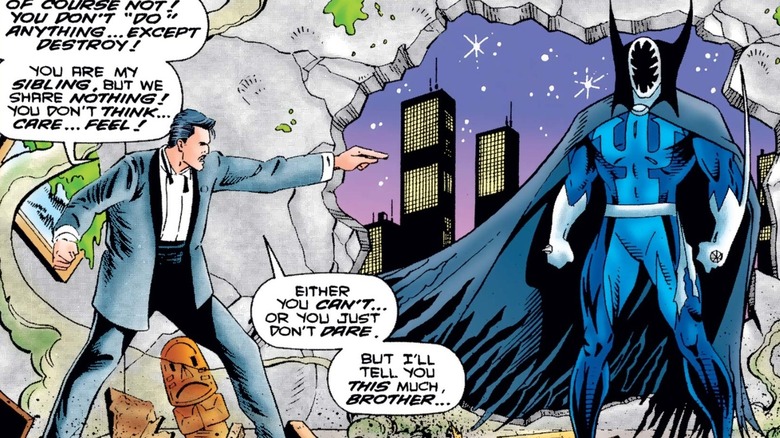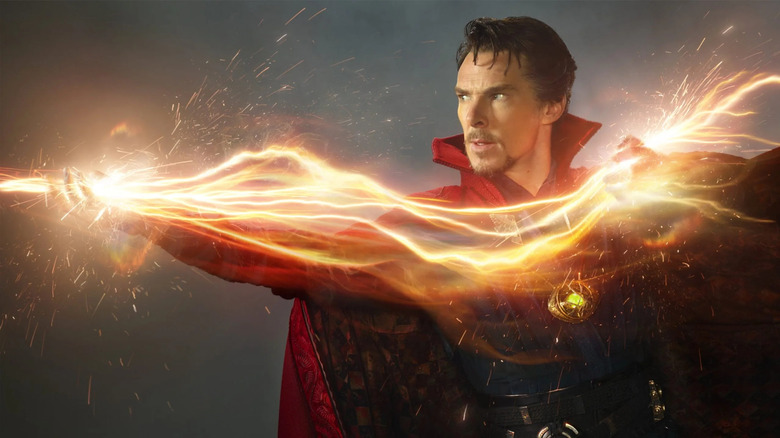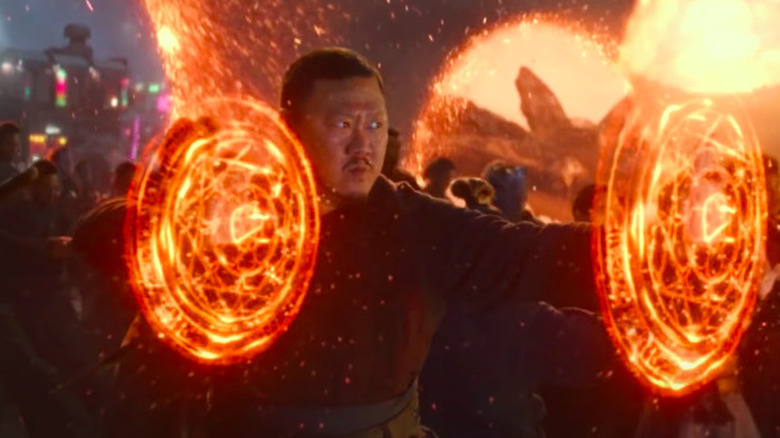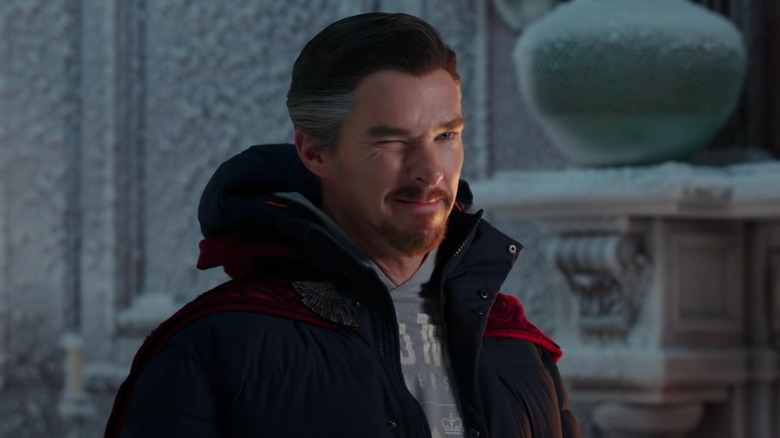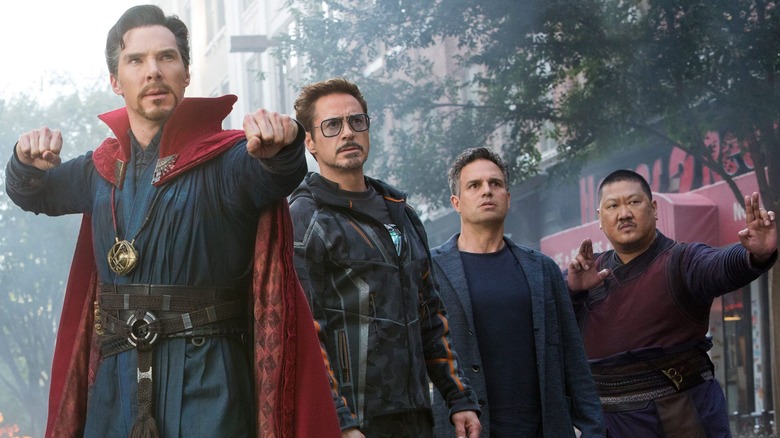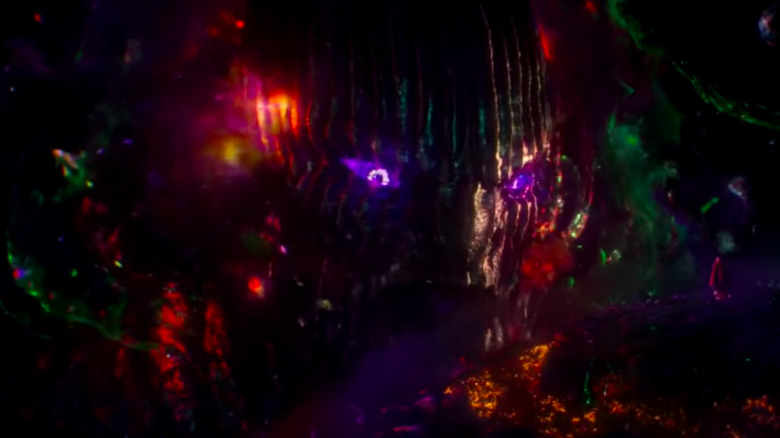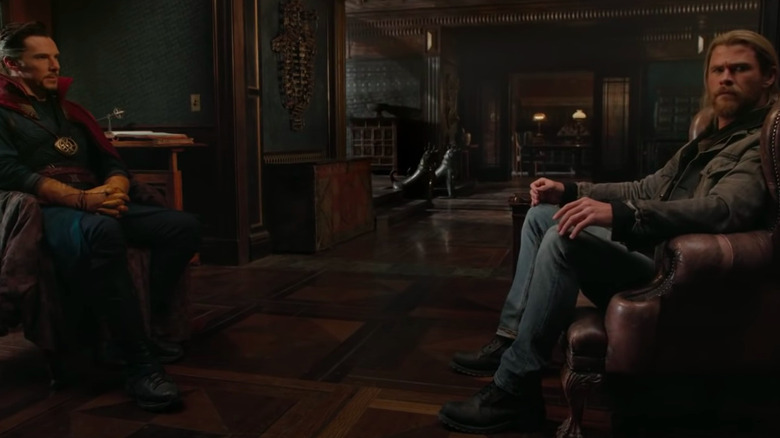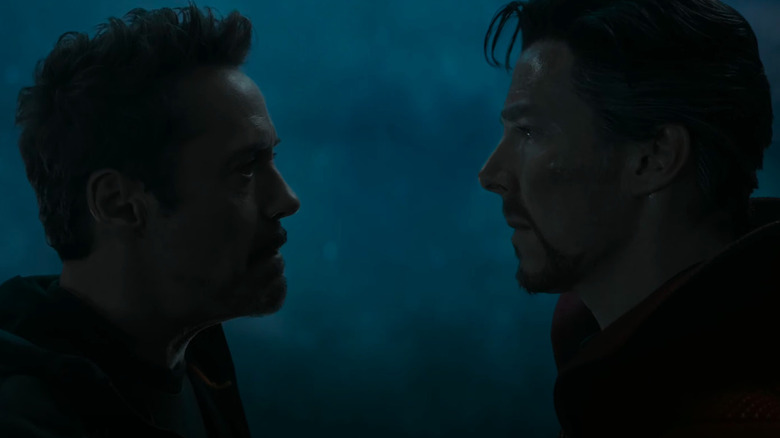All The Ways The MCU Movies Nailed Doctor Strange Better Than The Comics
There may be only one Doctor Strange movie out so far, but the Master of the Mystic Arts has already made an enormous impression in the Marvel Cinematic Universe, playing major roles in the last two Avengers movies ("Infinity War" and "Endgame") and "Spider-Man: No Way Home." Portrayed by acclaimed actor Benedict Cumberbatch, Stephen Strange has won over many an MCU fan and, thanks to May 2022's "Doctor Strange and the Multiverse of Madness," now has two solo movies to call his own.
What makes Doctor Strange's film popularity so impressive is the fact that his comic book counterpart, though a major presence in the Marvel Universe since his creation, has sometimes struggled to find that same success. It may seem sacrilegious to claim that an adaptation of Doctor Strange got the character more "right" than the source material, but the MCU version of the marvelous mystic has managed to avoid a few missteps the comics have made at times with the character, while simultaneously adding a few facets to Strange that can't help make you wonder why they weren't there earlier. In what ways, you might ask? Don that Cloak of Levitation and open your mind, as the Eye of Agamotto reveals all ...
They tone down his unusual catchphrases
Doctor Strange can say some pretty bizarre things when he's astonished. Often when something takes him by surprise in one of his comic book adventures, he'll exclaim things like "By the Eye of Agamotto!" or "By the Vishanti!", usually referencing one of the many mystical beings and artifacts he's encountered as a sorcerer. For many fans of the doctor, it's an endearing and intrinsic part of the character, with just the right amount of charm and melodrama as, say, Doctor Doom speaking in the third person.
Yet people not familiar with the melodramatic stylings of certain individuals in the Marvel Universe might find such lines a little off-putting and even (Hoggoth forbid) "corny." The movies make a smart choice, therefore, in keeping these kinds of phrases to a minimum in Doctor Strange's dialogue, limiting his shocked expressions of speech to words and phrases common to everyday conversation. The choice may not always be as fun, but it at least it avoids the risk of turning away the Doctor Strange cynics.
They keep his arrogance
In his origin story in "Strange Tales" #115, Doctor Strange is shown to be very proud, money-obsessed, and uncaring toward others before learning the mystic arts. After he suffers the fateful car accident that damages the nerves in his hands and becomes the Ancient One's pupil, however, he becomes a dramatically different person. While some takes on the character, such as Brian K. Vaughan and Marcos Martin's "Doctor Strange: The Oath" revive Strange's old pride to some extent, he's generally a more humble, agreeable man as a superhero.
While Strange's goodnatured (if at times slightly distant) demeanor in the comics is one of the things a lot of fans like about him, others find that removing his biggest character foible has made him a little too perfect. The MCU, perhaps taking such criticisms into account, stay fairly faithful to his origins without fully removing his arrogance. Though Strange definitely becomes a more selfless person, he still retains a certain self-assuredness that makes him come across as a bit curt or harsh at times. In excess, it could make Stephen hard to like, but when mixed in with his more positive qualities, Strange's ego helps make him a well-rounded character, introducing a foible that he must sometimes work to overcome. He also retains a certain coldness, mentioning both in "Avengers: Infinity War" and "Spider-Man: No Way Home" that he's willing to let individuals be sacrificed if he believes it services a greater good.
They keep him colloquial
While writers like Roy Thomas have tried to make Doctor Strange's dialogue less formal in comic book stories, Stephen usually has a very erudite speaking style that's big on vocab and light on contractions. While talking formally is one of Strange's signature traits (especially as it suggests great knowledge, as one might expect a Sorcerer Supreme to possess), it's also one of the things that makes him feel a little difficult for some fans to relate to, since he doesn't always talk like most people do.
Conversely, the Doctor Strange in the Marvel Cinematic Universe is hip with the lingo. While he's not spouting the most modern of slang words left and right (as that'd probably become a bit dated in a few years), he talks like a lot of people you might meet, while still coming off as the same sage mage comic fans have always known him to be ... minus several years of experience, of course. Interestingly, the 2015 Doctor Strange series by Jason Aaron and Chris Bachalo also opts to have the good doctor speak less formally than usual: a timely coincidence (or is it?) that some might say creates a stronger connection between the two versions of the sorcerer.
No drastic reinventions
It's probably not surprising to hear that every once in a while, a long-lasting company like Marvel Comics decides to experiment with its characters. That certainly holds true for Doctor Strange, who's gone through many different changes in creative direction over the years, sometimes gaining a brand new look in the process. One such incident happened at the end of 1994's "Doctor Strange: Sorcerer Supreme" #75 by David Quinn, Mark Buckingham and Peter Gross, where Stephen reinvents himself as a younger man (albeit with a couple of prematurely gray hair strands) while fighting and freeing himself from the influence of Salomé, an earlier Sorcerer Supreme. Strange's new look has all the hallmarks of '90s cool in comics, with stylish long hair (beat that, Superman's mullet!) and yellow sunglasses. Shockingly, his signature mustache is gone, and his Cloak of Levitation has become a long coat, somewhat mirroring the trench coat look of many popular comic and action heroes of the decade. Strange's powers are also altered, becoming closely connected to Earth's elements, and Stephen renames himself "Vincent Stevens" after a magical doppelganger of his.
It's a bold new look ... that barely lasts five issues. Perhaps recognizing the risk of pulling off similar stunts in live action, the MCU has instead stuck very closely to Strange's look and power set in the comics, with only a few minor alterations, including expanding the mustache to a goatee. Sometimes being hip just can't beat being iconic.
They don't overcomplicate him
The world of magic is a complex one, but Stephen Strange himself is pretty easy to understand. He's a brilliant ex-neurosurgeon who dedicates himself to becoming an expert in magic — not too complicated.
In the comics, however, things aren't always as clear-cut. At one point, the "Doctor Strange" comic book is populated by not one, but three versions of the same character. One is the true Doctor Strange, who decides to purge himself of the corrosive magic of the original Sorcerer Supreme, Salomé, in seclusion, while sending two mystical doppelgängers, or "Strangers," out in his place –the aforementioned Vincent Stevens, a smooth-talking technomage and mental manipulator who resembles Strange's classic look (minus the costume), and Strange, a costumed crimefighter with serious rage issues. The saga of the three Stranges, which starts in "Doctor Strange: Sorcerer Supreme" #61 by David Quinn, Melvin Rubi and Fred Harper, goes all the way up to #75, where the original Vincent Stevens is destroyed, the costumed Strange becomes "Paradox" after combining with Nobel the Progenitor, and Doctor Strange takes on Vincent's name and gets his aforementioned '90s makeover.
Confused? Don't worry: the story, though not without its moments, has a reputation for being a little complicated. So far, the MCU has chosen to forgo such storylines; while "Doctor Strange and the Multiverse of Madness" does feature multiple versions of Doctor Strange, fans should likely have no trouble identifying the real deal.
He's powerful within reason
Writing a Sorcerer Supreme can be tricky as far as power scaling goes. As the premiere mystic in the comic book Marvel Universe, Doctor Strange is by default more powerful than a lot of others versed in that discipline, capable of performing feats so incredible that's it's not always easy to conjure something that can challenge him. Furthermore, his abilities have varied greatly over time for a myriad of reasons.
While the MCU doesn't state them outright, it does establish more set powers for Strange, as well as specific rules for them, while also taking care not to overdo it in the power scaling department. For example, while the comics have shown Stephen manipulating and journeying through time with his own magic, the movies relegate all his time-related powers to the Time Stone: without it, as he explains in "No Way Home," he has no time powers, period. Furthermore, Strange requires specific items to make certain spells work, like his famous Sling Ring, which he and Wong use to create portals, and the Macchina di Kadavus, which traps spells gone awry. Strange's still plenty powerful, however, able to use spells like the Runes of Kof-Kol to make huge swaths of people forget a specific memory. That said, those have limitations too: if the Runes of Kof-Kol spell is altered repeatedly, for instance, it becomes increasingly unstable. Similarly, Strange can warp reality on a massive scale in the Mirror Dimension, but not in the normal world.
Reinventing Wong
Wong is one of the most well-known members of Doctor Strange's cast, having appeared as the person who assists Strange in his various duties as far back as "Strange Tales" #110. These duties include looking after Stephen's headquarters, the Sanctum Santorum. Though Wong has often been a partner to Strange in his adventures, his role in Stephen's world has come under scrutiny in recent years, including from Wong's MCU actor Benedict Wong and "Doctor Strange" director/co-screenwriter Scott Derrickson, with the latter revealing he'd almost omitted the character, noting to the Los Angeles Daily News that "he was an Asian sidekick manservant, what was I supposed to do with that?"
Though there are comic fans who may argue Wong evolved much from his earlier comic book depictions long before the first "Doctor Strange" film, the movie wisely sidesteps the controversy altogether by reimagining the character's role in Stephen's life substantially, making Wong a powerful sorcerer and one of the Masters of the Mystic Arts. In the first "Doctor Strange" movie in particular, he is someone who Strange goes to quite a few times to obtain knowledge, as Wong also oversees Kamar-Taj's library. Furthermore, Wong never goes to work for Strange in the New York Sanctum, instead continuing with his duties at Kamar-Taj, though he visits Strange's New York home often. "Spider-Man: No Way Home" in fact, even has Wong named the Sorcerer Supreme instead of Stephen, meaning he officially surpasses Strange in rank.
They emphasize his humor
Though not necessarily humor averse, Doctor Strange isn't generally known for cracking wise in the comics. As always, there've been exceptions — see again writer Roy Thomas and Jason Aaron's work on the character — but Strange tends to keep things serious when he's around, although some of his Strange-isms ("by the Rings of Raggadorr!") are bound to leave a smile on fans' faces. Some characters have even poked fun at him for it, such as in Keith Giffen, J.M. DeMatteis and Kevin Maguire's "Defenders" series.
In this, the MCU Strange noticeably differs. While he can get quite serious, as seen when guiding Iron Man in "Avengers: Infinity War" and "Avengers: Endgame," he also possesses a sardonic wit, which in his first film was overt enough to draw comparisons to the MCU's version of Tony Stark. While it has been toned down slightly, it has also become distinctly dryer than Tony's, and is part of what makes him likable. Given how this Strange has more hubris than the comics version, his humor works as an effective counterbalance to that trait: to lean too hard into his pride could steer fans away, after all. Strange's comedic side also plays to the strengths of his actor, Benedict Cumberbatch, who is known for having quite the sense of humor in real life.
They involve him with the Avengers early
Remarkably, Doctor Strange does not become an Avenger in the comics until many decades into his existence, joining a version of the team that opposes the Superhuman Registration Act in a 2007 issue of Brian Michael Bendis' "New Avengers" series. Of course, there are understandable reasons why writers might have been hesitant to add Strange to the team before: it can be hard to create villains that challenge both him and the rest of the Avengers, as Strange can handle a lot of big level threats on his own. Still, you'd think a team often nicknamed "Earth's Mightiest Heroes" would be quick to get Stephen on it, simply because he'd be so useful.
The MCU, perhaps realizing this, starts having Doctor Strange interact with the Avengers as early as his second appearance, where he aids Thor in "Thor: Ragnarok." And while Strange doesn't officially join the team in "Avengers: Infinity War," he works so closely with the group in that film and when he's resurrected in "Avengers: Endgame," that it practically feels like he is a member. Seeing as the Avengers might still be in operation in some form, as the mid-credits scene for "Shang-Chi and the Legend of the Ten Rings" seems to suggest, it may only be a matter of time before Strange — or, for that matter, MCU Sorcerer Supreme Wong, who's seen interacting with Bruce Banner and Captain Marvel – receive an official invite.
They make his adventures appropriately trippy
In his early comic book adventures, Doctor Strange lives up to his name in style. Thanks to the talented pencils of Steve Ditko, Strange would visit worlds that were truly wondrous and out there, becoming, as Vice notes, somewhat of a counterculture icon during the decade he was created. Ditko's style can be hard to match, and while quite a few artists have done some truly impressive work on the character, not all have chosen to go the psychedelic route, style-wise.
Conversely, the MCU and particularly the first "Doctor Strange" movie lean heavily into the psychedelia influence and include plenty of eye-popping visuals in its Stephen Strange scenes, such as during Strange's first meeting with the Ancient One and his truly astonishing-looking final showdown with Dormammu. "Doctor Strange and the Multiverse of Madness" continues in that vein, having teased its trippy visuals in many of its teasers and trailers.
They keep him important
For most of his existence in Marvel Comics, Doctor Strange has been the one of the top people superheroes go to for magical assistance. That said, there've been moments in Marvel history where Strange has appeared far less prominently, as he's gone notable stretches where he either hasn't had an ongoing series, co-starred in a superhero team book, or both. Amazingly, for example, nearly 20 years passed between 2015's "Doctor Strange" series and Stephen's previous ongoing, 1988-1996's "Doctor Strange: Sorcerer Supreme," though he did keep busy by joining teams like the Order and the New Avengers, not to mention showing up in plenty of mini-series and other superhero comics.
As far as the Marvel Cinematic Universe goes, however, Strange has never stopped being prominent. He plays a significant role in "Thor: Ragnarok" helping Thor and Loki find their father, Odin, and becomes an even bigger player in "Avengers: Infinity War" — not just by fighting Thanos, but also by revealing there's still chance of defeating him. In "Avengers Endgame," Strange is the one who teleports every superhero and Wakandan soldier brought back after the Blip to fight Thanos, while in "Spider-Man: No Way Home," it's his spell gone awry that nearly dooms reality. In short, the MCU knows that Strange is not a character to let fall by the wayside, made even more evident by the fact that he's the character chosen to burst the multiverse wide open in "Doctor Strange and the Multiverse of Madness."
The Doctor Strange-Iron Man rivalry
While they've been at odds at times ideologically in the comics, such as during the "Civil War" crossover and its aftermath, Iron Man and Doctor Strange otherwise tend to get along pretty well. They even work together in various permutations of the Illuminati, a secret cabal of influential Marvel Universe superheroes that handle crises they think are best resolved under the radar.
Because friendships are often based on commonalities, you might almost think that Tony and Stephen might have gotten along even better in the Marvel Cinematic Universe, where they have even more personality traits in common. They are both, after all, wisecracking egotists who learn to care more about others after a life-changing experience. Yet, the MCU wisely uses their similarities to put them at odds with one another. Tony starts out balking at Stephen's attire and commitment to mysticism, while Strange has no patience for Iron Man's snark and skepticism toward the mystic arts. The move is a clever way of addressing certain criticisms leveled toward the first "Doctor Strange" movie, where some felt that Strange is portrayed too similarly to Robert Downey Jr.'s take on Iron Man, by turning the characters' commonalities into a source of friction. Making the two characters rivals also underscores their differences, as science and magic are by definition opposing disciplines.
